Table of contents
- Additional safety through assistance systems Radar warner, blind spot assistant and co.
- ABS – the mother of all assistance systems
- Cornering ABS for motorcycles
- Slip preventer with cold gas
- Radar-based assistance systems
- Motorcycle assistance systems
Security campaign
Consideration has right of way

Yixin Chen
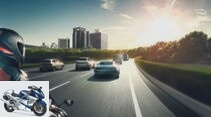
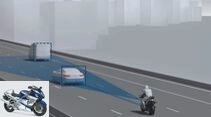
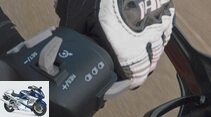
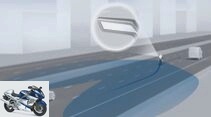
7th pictures
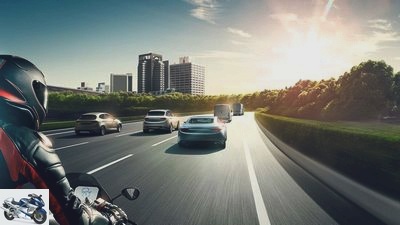
Yixin Chen
1/7

Bosch
2/7
Adaptive Cruise Control adapts the speed to the flow of traffic and maintains a safe distance from the vehicle in front.
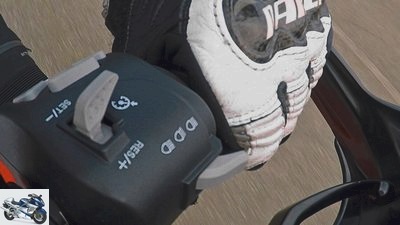
Bosch
3/7
Conveyance travel is safer and more relaxed.
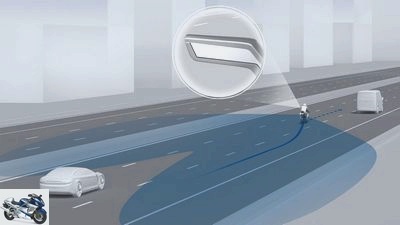
Bosch
4/7
The blind spot detector uses a radar sensor in the rear as an electronic eye.
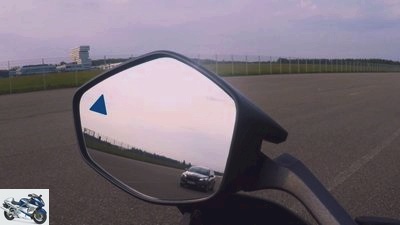
Bosch
5/7
A visual notice in the mirror signals to the driver when there is an impending danger.

Bosch
6/7
Collision warning: If the driver does not react to a critical approach to the vehicle in front, a visual warning is given, but no braking intervention.
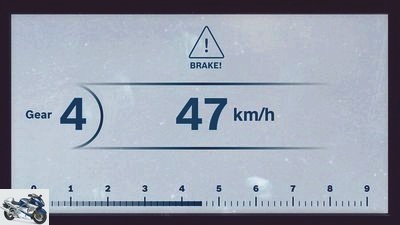
Bosch
7/7
According to estimates by Bosch accident researchers, radar-based assistance systems could prevent every 7th motorcycle accident.
counselor
technology & future
Additional safety through assistance systems
Additional safety through assistance systems
Radar warner, blind spot assistant and co.
With radar technology, Bosch is opening a whole new chapter in motorcycle assistance systems: Among other things, it allows automatic speed and distance control. This pioneering innovation is now being used at BMW, Ducati and KTM.
05/27/2021
In the Bosch vocabulary, the name is short and sweet ARAS – the acronym stands for Advanced Radar Assistance Systems. In the equipment lists of BMW, Ducati and KTM, on the other hand, there is talk of Adaptive Cruise Control (ACC), cruise control or adaptive cruise control. Nevertheless, the same thing is meant: a new generation of assistance systems that can also capture the motorcyclist’s surroundings.
ABS – the mother of all assistance systems
More than 30 years ago, BMW first offered an anti-lock braking system (ABS) for the K-100 series, heralding the age of electronic safety technology for motorcycles. ABS is now mandatory for all newly registered machines across Europe. The anti-lock system is practically the mother of all assistance systems, and on its triumphant advance up to the must-have equipment it has had a number of daughters: for example, traction control, which uses the existing ABS sensors (wheel speed) to prevent the rear wheel from spinning by regulating it intervenes in the engine control, i.e. taking the gas back accordingly. The same applies to the wheelie and stoppie control – also called rollover preventers.
Cornering ABS for motorcycles
Owing to the fact that 46 percent of all motorcycle accidents happen in curves, the Bosch accident researchers came to the conclusion years ago that the ABS should be expanded to include a mechanism for stability control. In 2013 – less than five years after the start of the MSC (Motorcycle Stability Control) research project – this type of ESP for motorcycles went into series production. In 2014, KTM was the first motorcycle manufacturer to use Bosch cornering ABS in the 1190 Adventure. In addition to the engine control, it includes the lean angle sensors (gyro sensor) in the control. Under normal conditions, this allows the driver to step safely into the irons even at an incline of 40 degrees, without the risk of falling due to excessive slippage. The trick: the brake pressure is reduced by the increasing lean angle. In the meantime, stability control has become almost standard equipment on new motorcycles – at least in Europe.
Slip preventer with cold gas
Bosch researchers are currently working on increasing cornering stability, for example when driving over oil stains, sand or wet leaves. They demonstrated to the public three years ago how this could work: The “Sliding mitigation” ignites so-called cold gas generators, such as those used in car airbags, as soon as the MSC sensors detect that the front wheel is slipping. The gas escapes with a bang through a side nozzle. The recoil generated in this way virtually compensates for the lost lateral guidance and pushes the machine back on track. Yes, we can! But at the moment the slip prevention device is still a dream of the future from Bosch accident research.
Radar-based assistance systems
With the implementation of radar-based assistants, the manufacturer is now going one step further in realizing the self-imposed three-stage security concept. ABS and MSC stand for accident avoidance and improvement of driving stability, ARAS now provides a precise picture of the vehicle environment, and the third stage is ultimately aimed at networking vehicles and traffic infrastructure. According to the Bosch accident researchers, radar-based assistance systems such as adaptive cruise control (ACC), blind spot warning systems and collision warning systems could prevent every seventh motorcycle accident. You are never distracted and, if necessary, always react faster than humans – the radar acts as the machine’s sensory organ. The technology behind it: a combination of radar sensor, braking system, engine management and the interaction between man and machine.
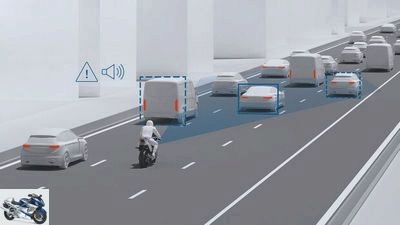
Bosch
If the driver does not react to a critical approach to the vehicle in front, a visual warning is given, but no braking intervention.
What sounds so simple now was a huge challenge for the developers. Although the application originates from the car like so many other things, the transfer to the two-wheeler turned out to be far more demanding. As banal as it may sound, a motorcycle is not a car. Starting with completely different input parameters for the driver’s position, steering characteristics, driving dynamics, braking behavior and operating conditions, right up to more cramped accommodation options for the radar sensors.
ACC also marks a milestone in that, for the first time, the system actively supports the driver with controlled deceleration to maintain a constant safety distance. One thing is clear, however: In emergency situations, the driver has to brake himself as much as he can, as a limited delay is stored in the system, which is not nearly as effective as in the car.
The distance radar is part of the standard equipment of the KTM 1290 Adventure S. BMW charges a surcharge of 500 euros for this extra safety feature on the R 1250 RT. And in Ducati’s Multistrada V4 S, the cruise control is combined on top with a blind spot warning – but only available in a package with side case, main stand, heated grips and heated seats at a slim price of 2,150 euros.
Motorcycle assistance systems
Already available:
- ABS / cornering ABS
- Traction control
- Wheelie / stoppie control
- selectable driving modes
- Cruise control
- electronically adjustable chassis
- Shift assistant
- Launch control
- Pit lane limiter
- Tire pressure control
- Drag torque (engine braking) control
- Hill start assist
- eCall system
- Blind spot assistant (ultrasound)
- adaptive headlights
- adaptive break light
- Automatic start-stop
- adaptive cruise control
- Blind spot warning (radar based)
- Collision warning
Planned:
- Lane Keeping Assist
- Headlight assistant
- Traffic Sign Recognition Assistant
- Emergency brake assist
- Vehicle-to-vehicle / -to-X networking
Related articles
-
Kawasaki with radar-based assistance systems from 2021
Motorcycle fair in Milan EICMA 2021 Presented by Kawasaki counselor technology & future Kawasaki with radar-based assistance systems from 2021 Kawasaki…
-
KTM counselor technology & future Ducati KTM safety systems Ducati and KTM safety systems Front and rear radar ready for series production by 2020 Ducati…
-
Driver assistance systems for motorcycles
Hirano Ami counselor Driving experience & Driving tips Driver assistance systems for motorcycles Assistance systems For comfort and security Motorcycles…
-
New Bosch motorcycle safety systems
Bosch 17th pictures Bosch 1/17 To make motorcycling even safer, Bosch is developing numerous new assistance systems. Bosch 2/17 Motorcycles should learn…
-
Electronic driver assistance systems for motorcycles
Yamaha 35 pictures www.factstudio.de 1/35 How things are going? It was a long way from the almost purely mechanical cockpit of the Yamaha SR 500 to the…
-
Active safety systems in motorcycles
Bosch 10 pictures MOTORCYCLE archive 1/10 ABS – Should prevent the wheels from locking when braking hard or on slippery surfaces. KTM 2/10 “Cornering ABS…
-
Ducati 1299 Panigale assistance systems coordinate setup
markus-jahn.com 28 pictures fact 1/28 Ducati Superbikes in a generation comparison. fact 2/28 Bite-proof and easy to dose: anchor of the 1198. ABS was…
-
Assistance systems: traction control in the test
Jahn 13th pictures Jahn 1/13 The relations shift on the wet test track – in the truest sense of the word. Jahn 2/13 In conclusion, it can be said that…
-
Bosch counselor technology & future eCall systems for motorcycles eCall systems for motorcycles Challenges in accident detection and emergency calls A…
-
BMW Motorrad Active Cruise Control (ACC): New assistance system
Topic special Everything about BMW Motorrad BMW motorcycle. 8th pictures BMW motorcycle. 1/8 BMW has presented a new assistance system called Active…